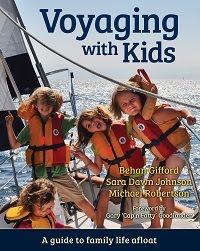 |
| The Chaotic Pendulum in motion. |
“They announced it on the news last night.”
“Huh, I missed that.”
Those days are gone. I can’t think of a lifestyle that would keep me more in tune with the weather than the cruising lifestyle. Windy and I often know what the conditions are where we are and what they are at a weather buoy twenty miles offshore. We usually know the forecast for the next ten days and how that forecast has evolved over the past 48 hours. When we’re passage planning, we look at the forecast twice a day—covering a 500-mile stretch of coastline. Planning two trips across a shallow inlet in King Salmon recently, we could tell you on what hour the high and low tides fell those days. Will there be moonlight on the nights of that upcoming passage? We know.
 |
| Eleanor quenching her thirst at a drinking fountain in the museum. |
I’ve always heard how difficult it is to predict weather, how the ever-increasing speed and computing capacity of super computers is being brought to bear on the problem, but that there is still a long way to go. I accepted this, but I never understood the reasons for it until we took the girls to San Francisco’s Exploratorium. There, they had on display a Chaotic Pendulum that made it all clear. This thing has three interconnected pendulums that all swing about the same axis when a knob is turned.
Apparently (and intuitively), there is no reasonable way to predict the movement of the interconnected pendulums. While the movement of a single pendulum would be easy to predict with knowledge of mathematics and the input forces, it is exceedingly difficult with multiple, interconnected pendulums. Not impossible, but any very slight error in terms of the input forces or the friction on a single arm, anything…and the calculus of the motion quickly becomes flawed, at odds with reality.
And so it is with weather systems. When multiple areas of circulating high and low pressure systems collide in a three-dimensional space, it is just like the Chaotic Pendulum—nearly impossible to predict the outcome, except in the very near term, such as related on the nightly news, for those who pay attention.
--MR |
| An interesting aspect of marine weather/wind forecasts is the nature, or pattern, of the air flow. Out at sea, air masses flow uninterrupted by changing topography--an additional contributor to chaos. This results in consistent flows over large geographic areas. In this PassageWeather.com screenshot, note the difference in wind direction and strength over land and sea (this is the entire coastline of the Baja California peninsula). |
 |
| Eleanor standing before the Palace of Fine Arts, just outside the Exploratorium and built in 1915. |
 |
| Also at the Exploratorium when we visited was a full-scale mock-up of the Curiosity rover that just landed on Mars. Have you seen Seven Minutes of Terror? (You must.) |


























